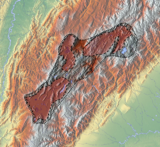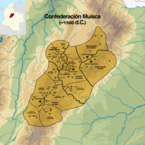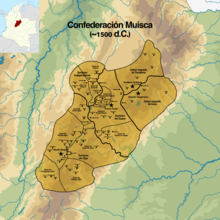Aquiminzaque
| Quiminza | |
|---|---|
| hoa | |
 Aquiminzaque, the last ruler of Hunza | |
| Reign | 1537–1540 |
| Predecessor | Eucaneme |
| Successor | Position abolished |
| Born | unknown Muisca Confederation |
| Died | 1540 Hunza, New Kingdom of Granada |
| Chibcha | Quiminza |
| Dynasty | Hunza |
Aquiminzaque (Chibcha: Aquim ó Quiminza, died Tunja, 1540) was the last hoa of Hunza, on which the Spanish city of Tunja (in present-day Colombia) was built, reigning from 1537 until his death. His psihipqua counterpart in the southern area of the Muisca was Sagipa. Aquiminzaque was for the Muisca what Túpac Amaru was for the Inca; and as the Inca leader, Quiminza was executed by decapitation.
Biography
Aquiminzaque was the nephew of his predecessor, Eucaneme. Aquiminzaque‘s reign began on August 2, 1537, when Eucaneme was taken prisoner to Suesca by the Spanish.[1][2]
Aquiminzaque ruled over the northern area of the Muisca in present-day Boyacá, Colombia in the years when the Spanish conquistadores were entering the highlands of the Muisca.
At first Aquiminzaque converted to Catholicism, but when he realized the true motives of the Spanish conquerors over the Muisca people, he revolted against them, undermining the initial rule of Hernán Pérez de Quesada, brother of Gonzalo Jiménez de Quesada. Shortly after, in 1540, Hernán executed Aquiminzaque by public decapitation in Tunja.[3] The spectacle, meant as an example, was watched by the Muisca people and executions of other caciques of Toca, Motavita, Samacá, Turmequé and Sutamarchán followed.
The death of the last hoa meant the end of the Muisca Confederation.
Legacy
In Tunja, the capital of the Boyacá department, a statue honouring Aquiminzaque (Monumento a la Raza Indígena) has been erected.[4]
Aquiminzaque in Muisca history
| History of the Muisca | |||||||||
 | |||||||||
 Altiplano |
 Muisca |
 Art |
 Architecture |
 Astronomy |
 Cuisine |
 El Dorado |
 Subsistence |
 Women |
 Conquest |
Text is available under the CC BY-SA 4.0 license; additional terms may apply.
Images, videos and audio are available under their respective licenses.

